Simple SEO Checklist- your path to higher Google rankings, every single time
Whenever you publish a new article, you have two courses of action before you:
You can sit back, relax, pour some coffee; or whiskey; or whiskey in coffee (you don't have to be Irish to do enjoy their beverages); and wait for Google to recognize your awesome work and give you the rankings you truly deserve.
Or you can get busy, bustle about and make Google give you the rank you deserve.
I recommend the latter and that's why I wrote this article. In it I give my own, simple SEO checklist that I follow to the tee before hitting that blue "publish" button.
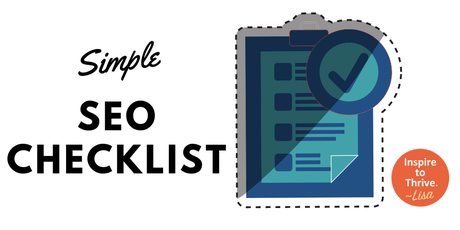
This is mostly on page SEO with a dash of link equity flow- it's powerful stuff!
So powerful in fact, that if you do the 7 hacks I'm about to show you, you'll be well on your way to dethroning the current king of the SERPS.
They're king, but for how long, right?
Number one position- prepare to meet your new lord and master... ( your name goes here) 🙂
#1- Content length- go for the average
It's great, wonderful to have exceptional content, because it helps you stand out. But most of the time- it's not needed.
Google is telling you what they expect to see from your page.
Simply type your keyword into Google, take the first 10 results and plug them into a free tool called " Hemingway App".
It'll tell you the word count of every post. Then you just need to find the average by first adding up word counts of all 10, and then dividing the number you get by 10.
And that's the ideal word count you should shoot for.
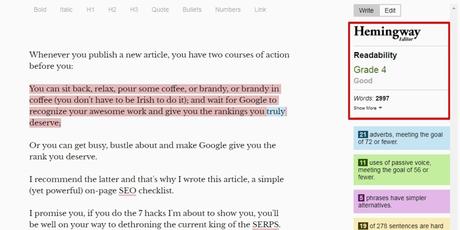
Hemingway app will also let you calculate the average reading score.
This is something to keep in mind because posts that're are written in simple English often get picked up to be featured in featured snippets and as voice search results.
Bonus tip #2I said go for the average, and I stand behind it. If you're chasing long tail keywords, there's no reason to blow up the SERPS every time you publish something new. Quality is important of course, but with long tails, you also need quantity.
However, if you're trying to target a really popular term, a head phrase that gets a tonne of searches every day and has insane competition- then you need to outdo everyone on the first page. If they write 1000 words, you write 2000. If they write 2000 you 4000 and so on.
Content comprehensiveness is an important ranking factor and it pays to get it right when targeting competitive terms.
#2- Get your basic metadata right
Note- What? I hope you didn't think that a simple SEO checklist can fly without some simple meta data. Simple, but powerful! Read below...
I said "basic" but I didn't say " weak", or "not powerful". Because that'd be a HUGE lie.
The right mixture of title tag, headline, and url, with a dash of well-crafted meta description goes a long way in signaling Google what your page is about and what they should rank you for.
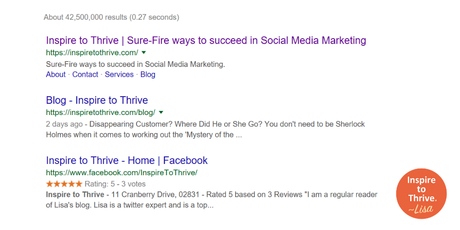
a) Meta title
Meta title, also called SEO title, is the blue link you see in the SERPS when you perform a search.
Its' the second most important on-page SEO factor (after content itself) and it pays handsomely to write it well.
Here's how:
- SEO title must be short- Anything over 60 characters or 600 px will be cut off in the SERP's
- Include your target keyword, and at the beginning if possible- if not, don't sweat it
- Write to get a click- SEO is important, but user engagement is crucial. Tell them what they'll gain if they click.
Writing good meta titles is an art, NOT a science. Meaning, you can read and reread those tips until you're blue in the face, but only by practicing and practicing, and then some more will you get proficient with it.
Here's the SEO title for this post:
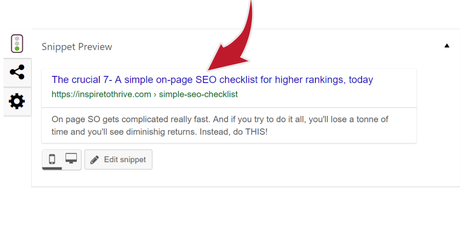
It's short, to the point, promising and inviting. And it took me a lot of time to learn to write like that.
Bottom line - don't feel bad if your SEO titles suck the first few times.
Practice makes perfect.
Pro tip:Use Portent's tool to visualize what you meta title will look like. You can also see your url and meta description.
b) URL
Short and sweet.Really- that's the advice.
- Short URL's rank better.
- Plus short URL's give a nice overview of the page.
- And short URL's are easy to read.
There no reason not to be concise because it's both SEO and UX friendly.
c) Meta description
The meta description is your ad copy, your "why" this page exists and "why" they need to click it.
To write them well, you have 2 options:
a) Expand the SEO title's messageYou have more room here, so make good use of it by telling something more about:
- the awesome gain of clicking on your listing,
- and the huge loss of not doing it.
Also, this is an easy way to insert your keyword here, as it won't look like keyword stuffing.
Here's the meta description for this post:
"A simple SEO checklist- for you. Don't get bogged down with the fluff. Do what matters the most and move on; with your business AND your rankings"Let's break it down real quick:
- A simple SEO checklist- my target keyword
- Don't get bogged down with the fluff- fear of loosing precious time
- Do what matters the most- what they get (most bang for their buck)
See? It works!
(But it takes practice to write like that)
b) Use ad copy- literally speakingIf your keyword is a lucrative one, you can bet there'll be a tonne of ads above organic listings.

Your job is to scan and pick up pattern words; i.e., those that come over and over.
This copy is valuable because it is usually tested to death. Use them words in your meta desc. and you'll get more clicks- guaranteed
#3 Heading Tags- relevancy booster and more
I'll talk about two types of headers,
a) H1 (the headline)
This is your post's true headline and is not visible from the SERP's itself. So, they have no impact on CTR.
Does that mean you can be careless about writing them? I mean, once they click- they're in!
And your job is done.
Well, of course not. But you knew that already, right?
Headlines have a huge impact on bounce rate and pogo-sticking, which are crucial user experience signals. Meaning, when people land on your page, the first thing they're going to see is your headline. And it has to be compelling enough for them to read on.
Like with SEO titles, writing headlines is an art, but here are some basic tips for you to start learning
- Try not to be clever- people hate to think online
- Be explicit and bodacious- Best headlines tell them what they'll get if they read on; and what they'll miss out on if they don't
- Use a target keyword- It's natural and people expect to see it, as it's a clue that they're on the right page
- Don't use more than one keyword. You can overdo it and people are not stupid
Coschedule has a great tool that can help you nail some awesome headlines. Make sure you use it.
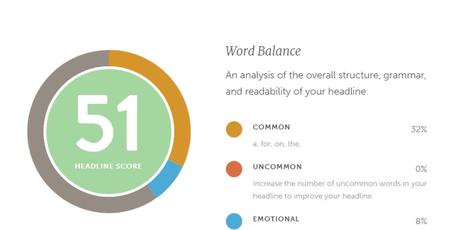
b) H2-H6 (the subheaders)
According to Content King App, keywords in "smaller" heading tags are still a ranking factor. They help you rank better by boosting your post's relevancy for the keyword you're chasing.
From that advice, we gather that we should use a keyword wherever it makes sense.
I said and repeat it "where it makes sense" Please don't go and try to stuff keywords where they clearly don't belong.
Header tags are a very small ranking factor and it is probable that when over-optimized, turn into spam signal for
It's scary, I know. One little element, so dangerous.
Dwell on it for a moment, then continue reading.
Pro tip- use content tables as further relevancy boostersTell me:
When you see a typical table of content, what does it usually consist of? Sub-headers turned into clickable anchors. And that anchors, when clicked transport you to parts of the page you want to read.
Well, isn't it possible that keywords in subheaders, combined with the same ones in content table (but turned into internal links); send strong relevancy signals to Google about what your page is about and what keyword cluster it should rank you for?
I think it is possible and I think that is the case with content tables. Of course the effect is small for sure, but it is also free and completely passive, so it's worth doing.
In other words, the page because more relevant for those keywords and ranks higher for them.
#4 images SEO image hack for relevancy boosting
Image SEO is SEO 101- that shameful number of people completely skip over.
Why is that?
Perhaps they think it doesn't matter? Do or do not, the ranking s stay the same.
Or maybe their reasoning is "we don't care about ranking in Google Images, so why should we bother"?
Here's why- well-optimized images boost your entire page's SEO! How's that for a reason?
Ahrefs has a great guide you should read, but in the meantime, read these basic tips so you can start optimizing images right away
- Keyword in image filename- like this: keyword-in-image-file-name
- Keyword in alt tag- "Here are seven on-page factor that matters the most"
- No keyword stuffing- Since folks can't see image SEO, people tend to stuff crap in there. Don't. Algo's are trained to spot and ounish that kind of shenanigans.
-
Use your main keyword once, and in your first image.
For other images further down the page- use LSI's (synonyms) - Describe the image- This is good usability for visually-impaired people.
Images help with your SEO a little bit, but you can boost their effect by boosting relevancy.
How?
Place images next to sub-headers, and make sure that the image alt tags contain the same keywords as the sub-headers.
That's double signal to Google that your page is about "your keyword".
Note- The guide from above is not about image optimization. I already pointed you to Ahref's guide for that. Above you will learn how to become independent of cheesy stock photos, and how to take images yourself, without expensive cameras and a bullion of pricey equipment you don't have.
Image SEO is one half of the puzzle; image quality is the other half.
Piece them together!#5- Internal linking for SEO
Internal links are a wonderful, underutilized part of on-page SEO. Which is something I really like because internal linking is my favorite hack to get an immediate SEO boost.
Here are a few tips that will get you pretty far.
a) Link relevantly
Links are the most important factor for Google. So saying that they pay attention to them is a huge understatement.
In fact, the Penguin algorithm is designed specifically to hunt bad links.
And link relevancy is is a telltale sign of link quality. The link that is thematically relevant to your site- helps you.
The one that is off-topic- hurts you.
And get too many of those- you get a penalty.
Now you're thinking "that's the case with backlinks, we're talking about internal linking here"!
The same rules apply! Relevancy must be maintained.
The only difference is that you won't be demoted because of internal links, but they will be nullified. Meaning the'll become sterile and won't pass PageRank and other link goodies.
b) Use anchor text
This is common advice but it bears repeating as it is important.
You can use keywords with internal links, yes even exact match anchors are fine. Of course, as always in SEO, there's a cap as to how far you can take it. You don't want to end up like Matt Diggity and his ergonomic chair disaster.
Here's a healthy link anchor distributor you can follow, boost your SEO, AND sleep well at night:
c) Use internal link co-occurrences
Google uses words around backlinks to determine the link's relevancy. Because they don't want to give weight to a non-relevant link
The same applies to words around internal links. The difference is that you control the words you so make them count for you.
d) Your new post craves authority- give them what they want
Google doesn't assign Page Rank to new posts and pages right away. In fact, they remain sterile for the first 3 months or so. And that's one of the reasons why posts take their sweet time to start ranking for stuff.
But the thing is- i t's not their fault!
And you should help them.
And here's how:
Point relevant internal links to your new post right away.
This post is about "on-page SEO", so I'll be combing through Lisa's site
like this: site:inspiretothirve.com on page SEO
And voila- several dozens of posts ready to share their link equity with their new infant brother.

Now:
Since I'm a guest here (thanks Lisa, it's an honor) it's up to her to link to this post and boos it quite a bit.
But this is the process YOU can apply to your site, and I suggest you do because more internal links= less backlinks.
The only drawback of this technique is that it can only be used on the posts you care about the most. Because you also don't want your post to be littered with links.
Ugly and ineffective.
#6- External linking for SEO
: Did you know that external links are good for SEO?
a) Put yourself in the same tier as the big guys
You want to show Google that you hang out with the squeaky-clean dudes in your niche. The ones where if you joined Panda and Penguin together; and Panda brings his telescope and Penguin brings his microscope, they'd still be able to find absolutely nothing. And their eyes would hurt from so much white hat brightness.
You achieve this by linking out to mega- authority sites. It's the singles easiest way to hint to Google- " yes, I belong". Pro tipLinking out to influencers is the easiest way to start doing outreach. Everyone loves a pat on the back, for a job well done.
For example, when I wrote this article on infobunny.com I like out to a bunch or influences (including Lisa). But I didn't do it willy nilly. I knew I was going to contact them right after the fact.
Here's my email to Lisa:
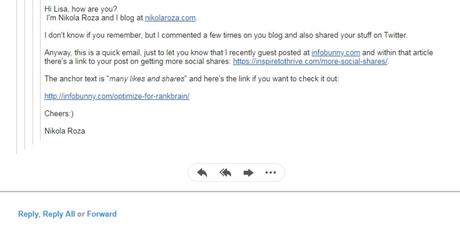
And here's me contributing to her site.
Is it just because I linked to her once?
No
As per her words, I also
- shared her stuff
- commented on her site
- engaged on Quora
- And I write very well (I say decent- my writing is decent, nothing special)
Bottom line - be helpful, be part of the community, give; and in due time you will get too.
b) Don't link out to strangers or "strange sites"
You know it; we all do. Don't link to any site you wouldn't want to show to a family member.
Google takes this seriously, so when you link to the good guys- you get bonus points. When you link to bad guys- you get negative points.
c) Page Rank is finite- your link count should be too
Page Rank flows through all links, internal and external. That is true for the old PR model but also for the updated version.
The conclusion is simple- limit the number of links on the page.
When you waste PR on unnecessary links you also weaken your internal links which are supposed to be helping you rank.
Because they pass equity throughout your site and help you rank better, especially your money pages which are typically reviews and don't get backlinks at all.
What are unnecessary links?Here are 3 sources of unnecessary links and it's up to you to decide how it applies to your site
#1- Huge menu's
Menu's with dozen of links are often viewed, but its links are rarely clicked on. Those remain unused to your dismay and to the despair of every other page that wants to rank, but can't because it doesn't have sufficient Page Rank flowing to it.
Solution- make your menu as simple as possible and see you rankings grow across the board.
#2- Bulky footers
Take a look at this miss:
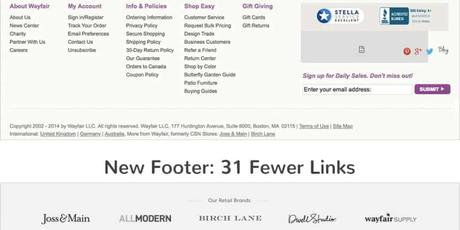
Does it look "right" to you?
It's wrong!
Dozens of unnecessary link stealing PR from other links that need it more. Don't have a bulky footer. Make it skinny and reap the rewards of a fit in shape website 🙂
#3- Bad practice linking out
Bad practice is anything that isn't specific.
For example, people mention SEO somewhere on the page, so they link to Wikipedia's page on SEO.
Or they mention links and they link to Brian Dean's backlink guide.
Those links are a waste of PR and everyone's time because people reading articles about SEO already know what SEO is. And people reading an article on, for xample, building links with images know what backlinks are and don't need to leave your site to relearn it.
Instead, use focused internal/external linking.
For example:
Good practice linking is just plain good sense.
#7- Increase your post's share potential
Your post thrives when it's seen and read by people. Only then can it help your business grow.
While that's true, but you don't have enough time and energy to promote it all the time.
Plus, it isn't practical.
So what are you to do?
The answer is to let others share.
And the easiest way is to use click to tweet boxes to encourage activity.
Here's how exactly:
Step 1- install the plugin from your WP dashboard (it's free).
Step 2 - Go into post's editor and choose a suitable place for your new tweet.
Then, Step 3 - open the shortcode generator and write the witty tweet.
Note- If your post is long, space them out a bit. The point is that when someone wants to share, they can easily do it because the click to tweet box is nearby.
That's it folks. My simple SEO checklist has run it's seven-part course. I guess all it's left is to conclude the article...
"What, there's a bonus"?
Oh yeah, now that you mention it...
🙂
Bonus- TF-IDF- Your secret weapon to EXTREME on-page SEO
What is TF-IDF?
The term stands for Term Frequency- Inverse Document Frequency.
Got it?
No?
Yeah, confusing, I know.
TF-IDF is one of the oldest Google ranking factors and one gaining in prominence ever since Google rolled out their latest big updates.
It's basically a way for Google to determine how relevant a post is to the query, by comparing it with the rest of the web. The relevant documents will contain (in higher percentage) words and phrases connected to the query, and not those that are unconnected or are miscellaneous.
They determine the relevancy by scanning the entire web of documents, but for your purposes, you want to match the relevancy of the first 10 results.
The words they have- you should too. The word they don't use anywhere but you do- kick them out, now!
To get results, you need a tool (it's free).
Introducing Site Auditor by Link Assistant
First, download and install the tool.
Second, get ready to learn.
TF-IDF is a really powerful ranking factor and nailing it right can help you rank without links. So it's beyond the scope of this article and I don't want to waste your time.
Instead I will direct you to a few helpful resource on the topic
And a helpful video/demonstration:
I urge you to give TF-IDF a try. Only the name is intimidating. The rest is easy. Plus most people have no idea what it is. You use it and get an easy advantage.
Conclusion- Never before has on-page SEO never seemed so easy, and so promisingly powerful...
Simple SEO checklist- 7+1 easy steps.
Do them! Religiously, stubbornly. But do them, even when you think on-page is the smallest part of the SEO equation do them. That it doesn't matter anymore.
Do them; and watch your new post go far.
It might not shoot to the first page right away. in fact, it certainly won't.
But it will be primed, pumped and ready to be promoted to the first page when the time comes.
And you can hasten its coming with a bit of page aging (out of your control ); and a dash of smart link building (hint: Lisa has a great guide on her site- read it!)
Here's the thing:
For the most part, whether you rank number #1 in Google, or not- is YOUR choice.
Now, what are you going to do about it? We would love to know more in the comments below!

